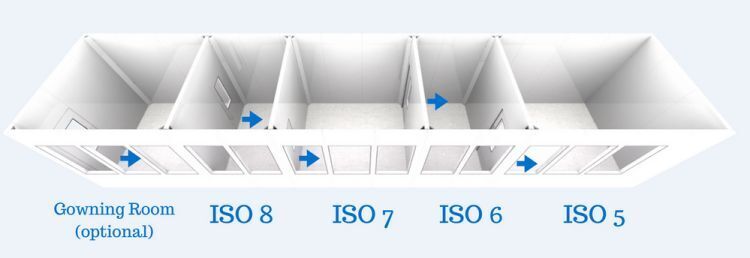ISO 6 Cleanroom Requirements
- 2024-02-02
- View 22
ISO 6 or Class 1,000 Cleanrooms are a high usage classification of cleanrooms across a variety of industries and application types. ISO 6 Cleanrooms are utilized in biotechnology, pharmaceutical, nanotechnology, and various cleantech manufacturing applications such as ion lithium battery, solar, medical device, film / packaging, and fine chemical.
In theory, for an entire room to reach ISO 6 air cleanliness, you need to enter the cleanroom via an ISO 8 (ante-room), then go through an ISO 7, to finally get into the ISO 6, as shown in the image.

In reality however, you can reach an ISO 6 cleanroom with 1 (recommendation is 2) airlock. Again, it depends of the size of the room, the process taking place inside the cleanroom, the number of people working inside, the equipment inside, etc.
Unidirectional air flow is sometimes recommended to reach ISO 6 classification. For a room of less than 4–6 meters in width (depending on the activities taking place inside the cleanroom), air returns can be positioned on the side of the walls instead of in the floor. Installing air returns in the floor is more expensive.
.jpg)
Common ISO 6 Cleanroom Requirements And Design Specifications
Filtration & Particle Control
Focused measurement of particle sizes greater than 0.5µ and less than 5.0µ
High Efficiency Penetration Air (HEPA) Filtration efficiency: 99.99% at 0.3 microns
Final filtration is performed at the air entry point of the cleanroom, and is commonly performed by terminal HEPA modules or HEPA FFU (fan filter modules) depending on the application.
35,200 PPC (particles per cubic meter) at 0.5µ
Environmental parameters such as temperature, humidity, lighting levels, noise criteria, static control, and outgassing are often driven by the requirements of the specific process being performed in the cleanroom.
Airflow & Air Change Rates per Hour (ACPH)
Unidirectional airflow or mixed air flow patterns typically used. Airflow is most commonly a vertical flow from the ceiling to the floor, returning for conditioning and filtration through low wall returns.
Filtration Ceiling coverage is 25-40%, with a randomized array with filtration located over the highest control areas.
Unidirectional airflow is utilized due to the more stringent requirements of ISO 6 cleanrooms.
Architectural Finishes
Wall systems: modular purpose-built wall systems depending on the application of the cleanroom. Biotech applications require non-shedding systems, with monolithic seams and coving to remove 90° angles, allowing wet washed down or VHP fogging to achieve sterile requirements. Nanotechnology and other non-sterile cleanroom types utilize non-shedding systems and are regularly dry wiped or vacuumed.
Ceiling systems:purpose-built ceiling systems are utilized for ISO 6 conditions depending on the application of the cleanroom. Biotech and pharmaceutical applications require walkable or panelized ceiling systems to promote monolithic washable surfaces, and access to maintain lights and filter media from the top side of the ceiling without breaching the certified and validated space. Nanotechnology and other non-sterile applications commonly utilize gasketed grid systems with non-shedding blank ceiling tiles where devices such as filtration or lights are not populated.
Flooring systems most commonly a resinous floor system, or heat sealed vinyl flooring system, with specific attributes depending on the application (i.e. chemical resistance, coving, static control, rolling weight loading / impact resistance, non-slip).
Miscellaneous architectural features to include types of doors, viewing windows, glass walls, pass-thrus, sprinkler heads / fire suppression, Wi-Fi / network access, security cameras, and access control devices.
Air Returns: Low wall return
Wall system: modular purpose-built wall system (Biotech sterile, Nanotech non-shedding)
Ceiling systems: purpose-built ceiling system (Biotech walkable ceiling, Nanotech gasket grid FFU)
Recommended Gowning & Housekeeping
Recommended gowning requirements: head cover, goggles, beard cover, lab coat, foot coverings or booties, and gloves suitable to the task (i.e. vinyl, latex, nitrile)
Gowning room: separate (typically a lesser pressure, and one classification less stringent; i.e. ISO 7 airlock) prior to entering the ISO 6 Cleanroom
No particle generation materials are allowed past material or personnel airlocks such as carboard, pallets, paper, dry erase boards, etc.
ISO 6 Cleanroom Requirements And Testing Required (ISO 14644-2)
Particle Count Test: maximum time interval 12 months, test procedure ISO 14644-1 Annex A
Air Pressure Cascade: maximum time interval 12 months, test procedure ISO 14644-1 Annex B5
Airflow: maximum time interval 12 months, test procedure ISO 14644-1 Annex B4
While the above criteria can be tested and certified on a 12 months interval basis, it is recommended to be done on an every 6 months schedule.
